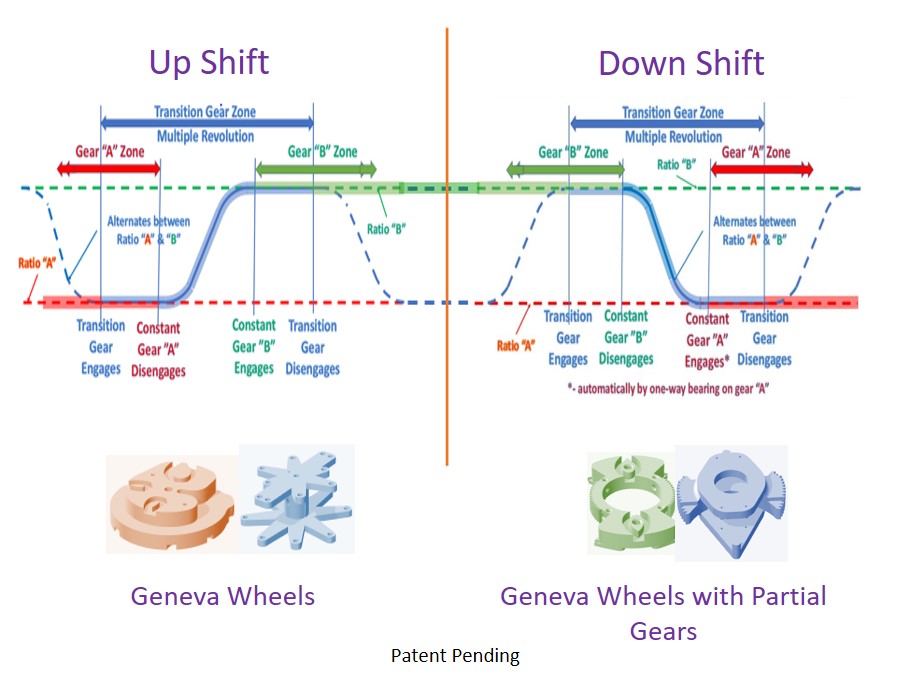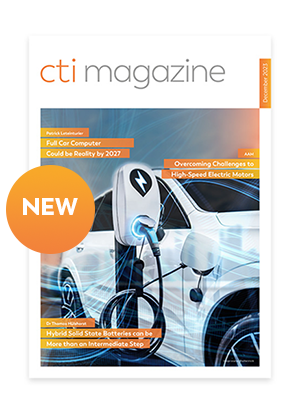
For the last several years, EcoNovaTech has been developing multiple innovative technologies to solve problems that are in the forefront of the automotive industry. With its latest developments, EcoNovaTech provides a paradigm shift in transmission technology with uninterrupted shifting and ALL gear-based transmission.
Multi-Speed Transmission with Uninterrupted Shifting (MSTUS) for EV:
OEMs are continually striving to increase the range per charge for EVs. Some OEMs now recommend not depleting the battery below 25% capacity, to extend its life. Battery charges relatively fast for the first 80% but the last 20% takes about as much time. Therefore, charging the battery up to 100% could take overnight. However, there are concerns that the battery can catch fire making it difficult for consumers to use the full capacity. Moreover, battery degrades depending on the frequency and number of times it is charged and discharged. A transmission that can improve the range will reduce this frequency thereby extending battery life. So, OEMs are actively looking for a multi-speed transmission in place of a single speed transmission to increase the range.
OEMs currently use two stage reduction for EVs. They are also actively looking into two speed transmissions with two stage reduction. Ideally, shifting occurs at around 40 – 45 miles per hour at which the wheel spins at about 650-750 RPM and the motor spins at about 6,500 – 7,500 RPM, since two stage reduction results in about one tenth the RPM of the electric motor. Current technology takes about 150 milliseconds of interruption for synchronizing and shifting, which causes a delay in achieving 0 – 60. So, a Multi-Speed Transmission with Uninterrupted Shifting (MSTUS) is desirable since it further increases the range, without affecting the time needed for 0 – 60. For electric motors spinning at 7,000 RPM the first reduction results in about 2,200-2300 RPM. This allows about 25-30 milliseconds for the transmission to shift over a full revolution, during the second reduction.
Smooth shifting occurs when the vehicle speed remains constant during shifting. Since vehicle speed is a product of motor RPM and angular velocity ratio, the change in this ratio should be inversely proportional to the change in motor RPM. Since the rotor of an electric motor has very low inertia when compared to IC engines, the RPM can be rapidly changed without changing the vehicle speed during shifting. As a result, occupants will not experience a jolt during shifting.
A recent experimental study using chain and sprocket mechanism for uninterrupted shifting shows that when shifting in about 19 milliseconds, most occupants may not experience the abrupt change in vehicle speed. However, use of chain and sprocket mechanism in transmissions is still in developmental stage. Noise and durability issues must be overcome. Chain and sprocket mechanism is not commonly used in transmissions in the industry.
Founded in 2014, EcoNovaTech has been dedicated to its mission of designing custom eco-friendly products through simple, effective engineering solutions and being a leader in Automotive Engineering. With its latest invention, EcoNovaTech now has two patent pending MSTUS solutions for EVs.
Both EcoNovaTech solutions use a transition module for shifting, and circular helical gears for transmission of power. The transition module has non-circular gears or Geneva pin and slot wheels cycling smoothly through all the angular velocity ratios used in the transmission, ramping up and down as needed. The transition module has functional and non-functional regions. The functional regions are the ramps followed by region of constant ratio. The non-functional regions are where the non-circular gears or Geneva wheels are rotated to complete an integer/reciprocal of an integer rotation of driving and driven shafts so that the whole cycle is repeatable. When the transition modules are in the non-functional region, they are disengaged from their respective shafts using dog clutches. Partial circular gears can be used for non-functional regions to reduce cost. Use of helical gears reduces the space required when compared to chain and sprocket with tensioner. Also, helical gears provide a smoother and quieter ride at higher efficiency, when compared to chain and sprocket systems. A pair of full Geneva wheels and a pair of Geneva wheels with partial gears are shown in the figure.
EcoNovaTech’s first solution is best suited for luxury passenger vehicles. For such vehicles, it is recommended that duration of uninterrupted shifting is extended when compared to current emerging technology, for a perfectly smooth ride. This solution uses a Duration Extender Module (DEM) that extends the duration of uninterrupted shifting to an optimal value of 30 – 50 ms (multiple revolutions) with zero interruption. DEM uses additional components, however is highly suitable for luxury passenger vehicles.
EcoNovaTech’s second and latest solution does not use a DEM and eliminates the short comings of the chain and sprocket solution that is currently being developed in the industry. In 2019, EcoNovaTech developed a solution for uninterrupted shifting without DEM using non-circular gears (patent pending). EcoNovaTech now has a less expensive innovative design (patent pending) that uses Geneva pin and slot mechanism with a customized slot, in lieu of non-circular gears, to transition from one angular velocity ratio to another. Geneva wheels can be mass produced at a lower cost when compared to non-circular gears. For EV, since the electric motor has a low inertia and can change the RPM instantaneously, shifting can occur within one revolution of the input from the electric motor. Since EV uses two stage reduction, it is advantageous to have the uninterrupted shifting happen in the second stage so that it spans a longer duration.
The operating principle of the MSTUS is explained below:
MSTUS uses 4 engaging and disengaging operations using dog clutches in series to achieve uninterrupted shifting.
To achieve smooth transition from one angular velocity ratio to another:
- While the transition module is in the same ratio as the transmission output gear ratio, the transition module is also linked to the output shaft.
- This is followed by unlinking of the transmission output gear to the output shaft while the transition module enters the ramp region.
- After the transition module ratio is transitioned to the target transmission ratio, the output gear set having the ratio matching the transition module ratio is linked in to the output shaft.
- Before the transition module cycles to next ramp region, it is disconnected from the output shaft thereby culminating the uninterrupted shifting.
All engagement and disengagement operations occur via dog clutches while the RPM of the gears and their respective shafts are synchronized, requiring minimal force to engage/disengage. A graphical representation of the above steps for up-shift from ratio A to B and down-shift from ratio B to A is shown in the figure.
Clutches in the industry take a minimum of 4 milliseconds to engage/disengage needing a total of 16 milliseconds for the 4-step operation. However, the need for 16 ms can be eliminated by sending the command 4 ms ahead of time for each operation.
Non-friction dependent IVT for HEV:
In a hybrid vehicle, since we have a combination of IC engine and electric motor, a smaller IC engine can be used. An IVT can get maximum power out of a small engine for a quick acceleration.
EcoNovaTech has two innovative IVT solutions, one using non-circular gears (patented in US, China and Japan, and patent pending in Canada and India) and its latest using Geneva wheel mechanism (patent pending), along with other COTS components.
The operating principle involves converting
- uniform rotation from the engine to non-uniform rotation using non-circular gears or Geneva mechanism
- non-uniform rotation from above to linear oscillation (a portion being uniform) of a rack using a scotch yoke mechanism
- linear oscillation of the rack to rocking motion of a pinion
- rocking motion of the pinion to a unidirectional uniform rotation of the output using a one-way bearing
The location of the pin in the scotch yoke mechanism dictates the angular velocity ratio.
With as low as 3 scotch yoke modules, a continuous and steady output can be achieved.
The ratio changing mechanism in EcoNovaTech’s solution uses a unique and simple feature enabling the relocation of the crank pin in a rotating coordinate system from a fixed coordinate system. This is used to change the input-to-output ratio for the transmission. The crank pin location can be changed purely mechanically at high RPMs so that it can be operated with a lever or cable. Planetary gears, computer controlled clutch or reversible one-way bearing can be used to achieve reverse gear. Use of reversible one-way bearing eliminates torque recirculation thereby reducing the peak load on the one-way bearing. This results in overall size reduction, since the size of the one-way bearing increases with the torque that is transmitted via the one way bearing.
Use of elliptical gears produce close results as non-circular gears, allowing ease of mass production since the driving and driven non-circular gears can be identical. EcoNovaTech’s latest IVT solution using Geneva wheel mechanism instead of non-circular gears will significantly reduce the manufacturing cost associated with non-circular gears.
EcoNovaTech’s eco-friendly innovative technical solutions can help OEMs progress towards the goal of Net-Zero Emissions by 2050 to help stop climate change.
Authors
Raja Rajendran MSME
President
EcoNovaTech LLC
Email: Raja.Rajendran@EcoNovaTech.com
Prashanth Rajendran MSME (PhD)
CEO
EcoNovaTech LLC
Email: Prashanth.Rajendran@EcoNovaTech.com

